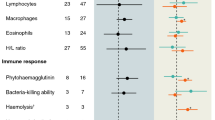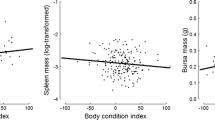Abstract
The avian spleen has been frequently used in studies of avian ecology, parasitology, and evolution to infer immune system strength in birds. Traditionally, it has been assumed that a large spleen is representative of a strong immune system and conclusions based on this assumption have led to interesting interpretations of the role of disease and parasitism, for example in predator-prey interactions. This assumption of a positive relationship between spleen size and immune system strength has been made despite an incomplete understanding of the physiology of the avian spleen and little evidence of the validity of such an assumption. In this response, we demonstrate that the assumption of a predictable, positive relationship between spleen size and immunocompetence may be unjustified based on what is known of avian splenology. We also review recent research that may indicate that the inverse of the above assumption is true and we discuss general limitations of the use of the spleen as an indicator of immune system strength in birds. Finally, we make recommendations for future research topics in this field of study.
Similar content being viewed by others
References
Brown CR, Brown MB (2002) Spleen volume varies with colony size and parasite load in a colonial bird. Proc R Soc Lond B 269:1367-1373
Ewart DF, McMillan DB (1970) The spleen of the cowbird. J Morphol 130:187-206
Hasselquist D, Marsh JA, Sherman PW, Wingfield JC (1999) Is avian humoral immunocompetence suppressed by testosterone? Behav Ecol Sociobiol 45:167-175
John JL (1994) The avian spleen: a neglected organ. Q Rev Biol 69:327-351
John JL (1995) Parasites and the avian spleen: Helminths. Biol J Linn Soc 54:87-106.,
Johnson G (2000) Bird-killing cats may be one of nature’s ways of making better birds. http://www.txtwriter.com/Onscience/Articles/killercats.html. Cited 5 August 2003
Møller AP, Erritzøe J (2000) Predation against birds with low immmunocompetence. Oecologia 122:500-504
Møller AP, Sorci G, Erritzøe J (1998a) Sexual dimorphism in immune defense. Am Nat 152:605-609
Møller AP, Sorci G, Erritzøe J (1998b) Host immune function and sexual selection in birds. J Evol Biol 11:703-719
Møller AP, Sorci G, Erritzøe J Mavarez J (1998c) Condition, disease, and immune defence. Oikos 83:301-306
Møller AP, Erritzøe J, Saino N (2003) Seasonal changes in immune response and parasite impact on hosts. Am Nat 161:657-671
Morand S, Poulin R (2000) Nematode species richness and the evolution of spleen size in birds. Can J Zool 78:1356-1360
Odum EP, Rogers DT, Hicks DL (1964) Homeostasis of the nonfat components of migrating birds. Science 143:1037-1039
Owens IPF, and Wilson F (1999) Immunocompetence: a neglected life history trait or conspicuous red herring? Trends Ecol Evol 14:170-172
Payne LN (1971) The lymphoid system. In: Bell DJ, Freeman BM (eds) Physiology and biochemistry of the domestic fowl, vol 2. Academic Press, London, pp 985-1037
Rose ME (1981) Lymphatic system. In: King AS, McLelland J (eds) Form and function in birds, vol 2. Academic Press, London, pp 341-384
Silverin B (1981) Reproductive effort, as expressed in body and organ weights, in the pied fly-catcher. Ornis Scand 12:133-139
Silverin B, Fange R, Viebke PA, Westin, J (1999) Seasonal changes in mass and histology of the spleen in willow tits Parus montanus. J Avian Biol 30:255-262
Sturkie PD (1943) The reputed reservoir function of the spleen of the domestic fowl. Am J Physiol 138:599-602
Wilson K, Bjørnstad ON, Dobson AP, Merler S, Poglayen G, Randolph SE, Read AF, and Skorping A (2001) Heterogeneities in macroparasite infections: patterns and processes. In: Hudson PJ, Rizzoli A, Grenfell BT, Heesterbeek H, and Dobson AP (eds) The ecology of wildlife diseases. Oxford University Press, Oxford, pp 6-44
Zohar AS and Rau ME (1986) The role of muscle larvae of Trichinella spiralis in the behavioral alterations of the mouse host. J Parasitol 72:464-466
Acknowledgements
We thank the staff of the Hodges Library at The University of Tennessee, Knoxville, without whose assistance this paper would not have been possible. We also thank two anonymous reviewers and M. Chappell for comments made on an earlier version of this manuscript.
Author information
Authors and Affiliations
Corresponding author
Rights and permissions
About this article
Cite this article
Smith, K.G., Hunt, J.L. On the use of spleen mass as a measure of avian immune system strength. Oecologia 138, 28–31 (2004). https://doi.org/10.1007/s00442-003-1409-y
Received:
Accepted:
Published:
Issue Date:
DOI: https://doi.org/10.1007/s00442-003-1409-y




